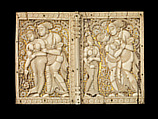Two box panels with mithuna couples
Not on view
These panels are outstanding examples of the arts of the Nayaka dynasty of southern India, known for their patronage of arts associated both with palaces and temples. Ivory carving was a celebrated art form in both realms. The sophistication of composition and execution of these panels point to major ivory workshops directly associated with the Nayaka courts. Notable examples of ivory religious imagery are preserved at Sri Meenakshi Sundareshwarar temple museum in Madurai and in the Srirangam temple Museum, Trichy, in Tamil Nadu. Paneled boxes, much favored examples of secular art, survive mostly in incomplete form with individual panels separated from the wooden casket. These two panels are closely related to others that were assembled in modern times, onto a single box; these related panels are now preserved in the Museum of Fine Arts Boston, and the Virginia Museum of Art. These are the last two panels from that ensemble, and represent a rare opportunity to secure high quality Nayaka court ivory carving.
These two panels each feature an amorous couple (mithuna) set within a cusped arch typical of late 17th century Nayaka palace architecture. The delicately carved figural groups stand against a pierced backdrop of leaves and flowers, the openwork offset against a gold ground. The panels are separated by a thin pilaster and framed by a band of rosettes.
Carved in low relief, the figures are animated by a complex system of overlapping elements and by the modulated planes of their bodies. The figures are stylistically distinct yet their garments and jewelry can readily be compared to 17th century life-size donor figures depicted in stone temples at Srirangam, Tanjore, Kumbakonam and Madurai. These temples are all located in the Cauvery River basin of Tamil Nadu, the likely production center for these ivory workshops. The thin column and cusped arches on the ivory panels are similar to the architectural elements of the distinctive arcaded courtyard of Tirumala Nayak’s (r. 1623-59) palace built in 1646 in the city of Madurai, and the pillared hall known as the Pudu Mandapa he commissioned outside the east gate of the Meenakshi Sundareshwarar temple (Guy 1990).
Due to rights restrictions, this image cannot be enlarged, viewed at full screen, or downloaded.

